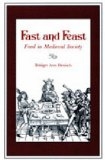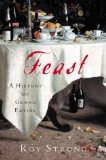-
History of:
- Resources about:
- More:
- Baby walkers
- Bakehouses
- Bed warmers
- Beer, ale mullers
- Besoms, broom-making
- Box, cabinet, and press beds
- Butter crocks, coolers
- Candle snuffers, tallow
- Clothes horses, airers
- Cooking on a peat fire
- Drying grounds
- Enamel cookware
- Fireplaces
- Irons for frills & ruffles
- Knitting sheaths, belts
- Laundry starch
- Log cabin beds
- Lye and chamber-lye
- Mangles
- Marseilles quilts
- Medieval beds
- Rag rugs
- Rushlights, dips & nips
- Straw mattresses
- Sugar cutters - nips & tongs
- Tablecloths
- Tinderboxes
- Washing bats and beetles
- Washing dollies
- List of all articles
Subscribe to RSS feed or get email updates.
...[a table] was set up attractively on trestles, Covered with a clean cloth, that showed clear white, Sanap, and salt cellar, and silver spoons...
The table of a "high lord" in Sir Gawain and The Green Knight, late 14C

Ian Mortimer, The Time Traveler's Guide to Medieval England: A Handbook for Visitors to the Fourteenth Century from Amazon.comor Amazon UK

Bridget Henisch, Fast and Feast: Food in Medieval Society, from Amazon.comor Amazon UK

In "serten artycles" for regulating his household, made by Henry the Seventh, in 1493, it is ordered, "the server to lay the surnape on the borde and the usher to drawe hyt [withdraw it] and to make the pleyghtes [pleats] before the kyng."
TH Turner, Usages of Domestic Life in the Middle Ages, in the Archaeological Journal, 1846

Roy Strong, Feast: A History of Grand Eating, from Amazon.comor Amazon UK

Tablecloths in the Middle Ages
Board-cloths and table linen for the rich and not-so-rich
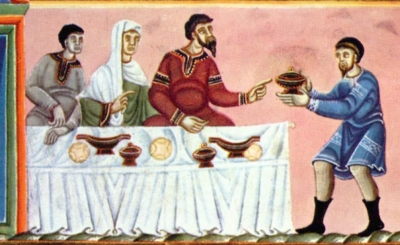 Fine table linen was essential
for fine medieval dining. In the late medieval period the best tablecloths were
as white as possible, ornamented with allover woven patterns, embroidery, separately
stitched coloured borders, fringes, stripes, or some combination of these. There
were plainer linen cloths for plainer people, and even rough hemp tablecloths on
more impoverished tables. If anyone in Western Europe had to manage without a tablecloth
they were at the very bottom of the social heap, like the washerwomen whose work
was essential to keeping the best linen as fine and white as possible.
Fine table linen was essential
for fine medieval dining. In the late medieval period the best tablecloths were
as white as possible, ornamented with allover woven patterns, embroidery, separately
stitched coloured borders, fringes, stripes, or some combination of these. There
were plainer linen cloths for plainer people, and even rough hemp tablecloths on
more impoverished tables. If anyone in Western Europe had to manage without a tablecloth
they were at the very bottom of the social heap, like the washerwomen whose work
was essential to keeping the best linen as fine and white as possible.
We know more about the best tablecloths than about humbler ones because we have descriptions of fine feasts, and also medieval paintings of biblical stories, especially the Last Supper, in which the artists wanted to portray linen suitable to their subject matter. Their ideas were taken from their own experience, not from an accurate historical knowledge. There are also a few tablecloths preserved in textile collections, like this 13C one from Switzerland, although it is not always absolutely clear what particular pieces were used for, as there is some overlap between table linen and altar cloths. Board-cloth or bord-cloth was the common English name for a tablecloth.
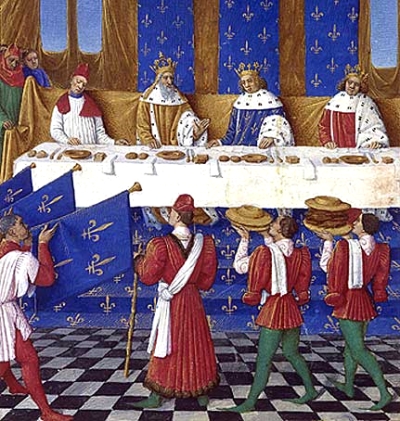 Tablecloths in rich
households often matched other smaller pieces of table linen. Servants carried cloths
that could be used in several ways - perhaps as a towel for diners after hand washing
at table. Some cloths were set out directly on the table. A sanap was placed over
the tablecloth in front of the highest status diners: either a strip running the
length of the table, or an individual sanap or sauvenappe (save-cloth). A surnape
was also a cloth laid over the main table cover.
Tablecloths in rich
households often matched other smaller pieces of table linen. Servants carried cloths
that could be used in several ways - perhaps as a towel for diners after hand washing
at table. Some cloths were set out directly on the table. A sanap was placed over
the tablecloth in front of the highest status diners: either a strip running the
length of the table, or an individual sanap or sauvenappe (save-cloth). A surnape
was also a cloth laid over the main table cover.
...routines for laying the table and covering side-tables and dressers became ever more elaborate through the fifteenth century. On a major feast day, the table was covered with a tablecloth, another tablecloth known as a surnape, as well as a towel, which was to be laid double if someone was of sufficient status to have a mess to themselves. The surnape which was probably decorated in some way was omitted on other days.
C. M. Woolgar, The Great Household in Late Medieval England
Ceremonial placing and removal of the sanap became an elaborate ritual for late medieval English royalty, with favoured servants or even courtiers having the honour of "[with]drawing the sanap", usually embroidered, trimmed with lace etc. Of course, table customs were not exactly the same from place to place, from generation to generation. In the 15th century French picture above left you can just see pleated cloths in front of the guests, apparently separate rather than one single long sanap.
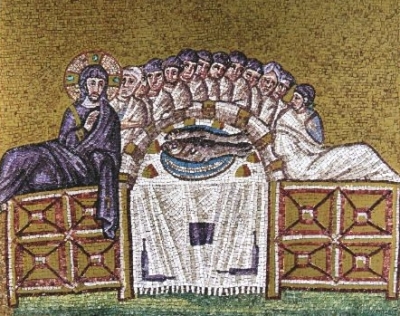 Fine European tablecloths are generally thought to have appeared in about the first
century AD. For a long time Roman diners gathered at tables too beautiful to cover.
Individual cloths were used more like napkins: for catching spills and wiping. The
poet Martial, who died c103 AD, is often cited as the
first writer to mention a tablecloth.
Fine European tablecloths are generally thought to have appeared in about the first
century AD. For a long time Roman diners gathered at tables too beautiful to cover.
Individual cloths were used more like napkins: for catching spills and wiping. The
poet Martial, who died c103 AD, is often cited as the
first writer to mention a tablecloth.
The use of tablecloths continued through early medieval times. The sixth century Byzantine mosaic (right) shows one. Tablecloths had reached northern Europe before the 10th century. Anglo-Saxon manuscripts have pictures of cloth-covered dinner tables. The one illustrated below is from a copy of a picture in a 10th century manuscript. A traditional Norse poem, first written down in the 13th century but recited by minstrels long before, says:
Then took Modir a figured cloth of white linen, and the table decked.
from Rígsþula, a mythological narrative poem and one of the Norse Eddas
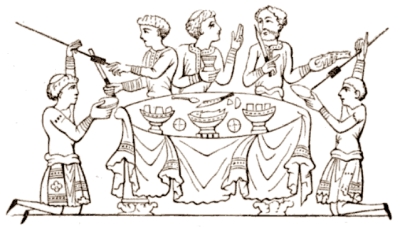 We should not underestimate how
valuable table linen was - not just finely woven diamond diaper, elaborate damask,
or blue and white "Perugia
towels". All linen had to be harvested and spun by hand, bleached, then
skilfully woven on a hand loom. Woven cloth was fulled, calendered, bleached again,
and once it was in use experience and hard work was needed to keep it looking good.
In some cities there were professionals who hired out table linen for big occasions
and presumably washed and pressed it. Some homes kept their table linen in a screw
press which smoothed it and made a nice show. The pleated folds created in
a linen press seem to have been treated
as an ornamental feature of some grandly laid medieval tables. We can also see its
value in wills and inventories.
We should not underestimate how
valuable table linen was - not just finely woven diamond diaper, elaborate damask,
or blue and white "Perugia
towels". All linen had to be harvested and spun by hand, bleached, then
skilfully woven on a hand loom. Woven cloth was fulled, calendered, bleached again,
and once it was in use experience and hard work was needed to keep it looking good.
In some cities there were professionals who hired out table linen for big occasions
and presumably washed and pressed it. Some homes kept their table linen in a screw
press which smoothed it and made a nice show. The pleated folds created in
a linen press seem to have been treated
as an ornamental feature of some grandly laid medieval tables. We can also see its
value in wills and inventories.
Tablecloths for peasants?
Table linen was not confined to grand households. In the later Middle Ages most meals were set out on a table covered with cloth. A 14th century English peasant farming a few acres usually had a simple tablecloth in his home, while a "modestly prosperous yeoman" might have a linen or canvas cloth hanging to the floor, according to Ian Mortimer in The Time Traveler's Guide to Medieval England. A well-established merchant would own a stack of white linen tablecloths, probably displayed somewhere in the home.
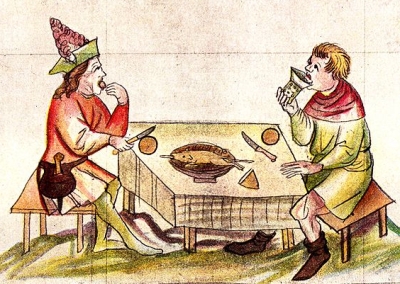 Pictures in medieval manuscripts show ordinary meals laid on good cloths. This 15th century French picture
of a farmers' snack has a particularly fine cloth, with a diaper weave and coloured
borders. Was the artist being unrealistic? Bruegel's 16th century
peasants' wedding uses just one strip of cloth down the middle of a long
trestle table. The men pictured right are in a 15th century MS of a 13th century
poem.
Pictures in medieval manuscripts show ordinary meals laid on good cloths. This 15th century French picture
of a farmers' snack has a particularly fine cloth, with a diaper weave and coloured
borders. Was the artist being unrealistic? Bruegel's 16th century
peasants' wedding uses just one strip of cloth down the middle of a long
trestle table. The men pictured right are in a 15th century MS of a 13th century
poem.
Cloth was sold in fixed widths according to the customary loom size in the area which produced it. Some tables were covered in two or three separate widths of cloth, suitably arranged. Lengths of cloth were bought and cut up into separate table covers and napkins.
Efficient laundering was essential to keep white cloth looking good. Some of the techniques would seem odd to us today: stain removal with urine, extensive "bucking" or soaking in lye using quantities of wood ash, and bleaching in the open air. Professional launderers probably had special equipment for smoothing linen - like rollers for calendering. At home, cloths could be smoothed in a linen press. Though hot ironing, with metal or earthenware "irons", was not unknown in the late medieval period, it was not as widespread as now.
Servants were instructed to clean tables before spreading cloths, and to take other precautions against soiling table linen.
More pictures at: Perugia tablecloths - medieval and renaissance and French National Library 'medieval gastronomy'
My son, it is now the time of day to lay the table. First, wipe it with a cloth ere it be spread, then lay on it a cloth called a cowche. You take one end and your mate the other, and draw it straight; and lay a second cloth with its fold on the outer edge of the table. Lift the upper part and let it hang even. And then lay the third cloth with its fold on the inner edge, making a state half a food wide, with the top. Cover your ewery-cupboard with a diapered towel, and put a towel round your neck, for that is courtesy, and put one end of it mannerly over your left arm; and on the same arm place your lord's napkin, and on it lay eight loaves of bread, with three or four trencher-loaves. [...]
With lowly courtesy, make the surnape with a cloth under a double of fair napery; fold the two ends of the towel to the outer edge of the cloth, and so hold the three ends together; then fold them all so that there is a pleat at about a foot's distance, and lay it fair and smooth for your lord to wash after meat, if he will. At the right side of the table, you must guide it along, and the marshal must slip it further - the right side up of all three cloths - and let it be drawn straight and even, both in length and breadth; then raise the upper part of the towel and lay it without wrinkling straight to the other side so that half a yard or an ell hangs down at each end, where the sewer may make a state, and so please his master. When your lord has washed, you must take up the surnape with your two arms, and carry it back to the ewery yourself.
John Wesley's Book of Nurture, c1460
 26 Feb 2010
26 Feb 2010
You may like our new sister site Home Things Past where you'll find articles about antiques, vintage kitchen stuff, crafts, and other things to do with home life in the past. There's space for comments and discussion too. Please do take a look and add your thoughts. (Comments don't appear instantly.)
For sources please refer to the books page, and/or the excerpts quoted on the pages of this website, and note that many links lead to museum sites. Feel free to ask if you're looking for a specific reference - feedback is always welcome anyway. Unfortunately, it's not possible to help you with queries about prices or valuation.



